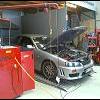Quick Turbo Comparison On Rb25
Announcements
-
Similar Content
-
Latest Posts
-
By Watermouse · Posted
Do u think Haltech will ever integrate the factory ABS into Nexus with the plug and play, eg; S3? or, is there way more practical/technical/tweeking advantages going a Bosch Msport ABS? like I grew up knowing how to jab brake, so for a street car, is it worth going the Bosch system? -
I will reiterate... Pull the ABS fuse... At a minimum, good test to see if it's actually being caused by the ABS system... At the other end of the scale, if the vibration is from ABS turning on, last thing you want is when you're trying to brake, having ABS kick in when it shouldn't and now you can't actually stop at all... At least with ABS unplugged the worst issue is you need to be aware you're the one that needs to modulate pressure in an emergency.
-
Uses the factory sensors? Which are currently the problem?
-






Recommended Posts
Create an account or sign in to comment
You need to be a member in order to leave a comment
Create an account
Sign up for a new account in our community. It's easy!
Register a new accountSign in
Already have an account? Sign in here.
Sign In Now